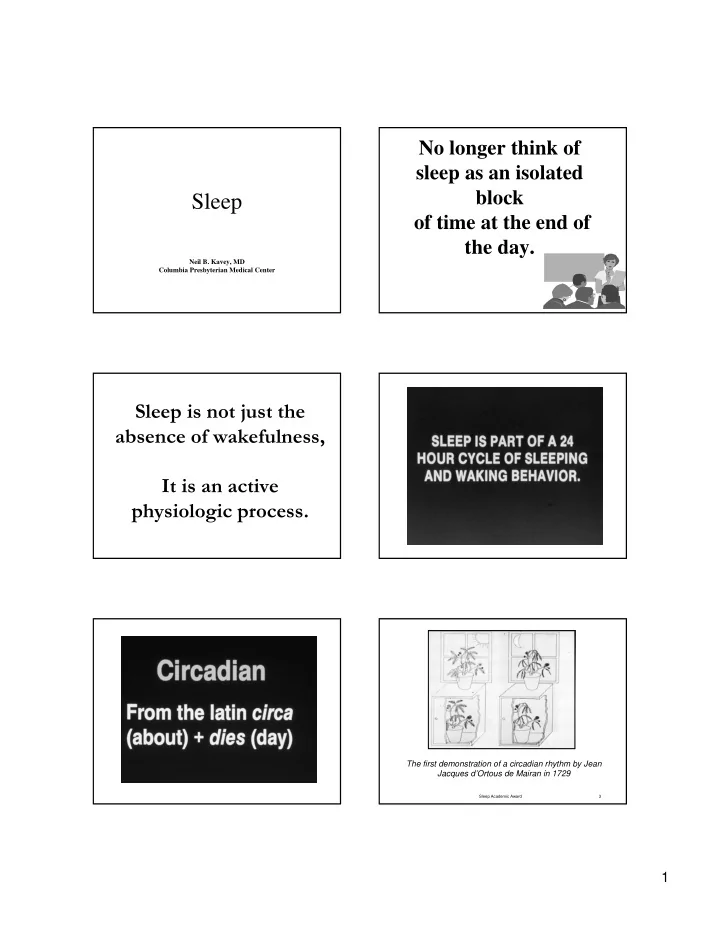

No longer think of sleep as an isolated block Sleep Sleep of time at the end of the day. Neil B. Kavey, MD Neil B. Kavey, MD Columbia Presbyterian Medical Center Columbia Presbyterian Medical Center Sleep is not just the absence of wakefulness, It is an active physiologic process. The first demonstration of a circadian rhythm by Jean The first demonstration of a circadian rhythm by Jean Jacques d’Ortous Jacques d’Ortous de de Mairan Mairan in 1729 in 1729 Sleep Academic Award 3 1
Evening Evening Over a 24 hour period two discrete systems flow one into the other. Activating systems Sleep systems decrease action increase action 4:30 am 4:30 am Our biological clocks are demonstrated in jet lag Sleep systems Alerting systems decrease action increase action 2
3 types of studies to localize sites Neuroanatomical Neurophysiogical 1. Transection 2. Stimulation Neurochemical 3. Lesion Studies To localize sleep and wakefulness Beginning in the 1930’s 1. Electrical stimulation of the brainstem reticular formation, but not the sensory pathways, produced cortical activation consistent with wakefulness 1940’s Moruzzi and Magoun 2. Lesions in the same area produced cortical deactivation and slow waves 3. Most effective lesions that produced cortical deactivation were in the midbrain and extending forward into the posterior hypothalamus This became known as the: ASCENDING RETICULAR ACTIVATING SYSTEM 3
The same types of studies showed that: Stimulation of certain areas of the brainstem such as the medullary reticular formation ( Nucleus of the solitary tract) produced cortical synchronization (sleep) Lesions of these specific regions produced cortical activation (wakefulness) State Generators State Generators Most recently the HYPOTHALAMUS has emerged as an area of great importance for both sleep and wakefulness This next slightly different schematic of the cat brain shows the sites of study by Jouvet and colleagues REM sleep promoters – cholinergic neurons of the roof of the pons – REM ON Laterodorsal tegmentum (LDT) Pedunculopontine Tegmentum (PPT) REM sleep suppressors – monoaminergic neurons REM OFF Locus Ceruleus (noradrenergic) Raphe Nucleus (serotinergic) 4
Neurochemical regulation of awake Neurochemical regulation of awake and sleep and REM and Non- and sleep and REM and Non -REM REM � Adrenergic Adrenergic � � Cholinergic Cholinergic � � Serotonergic Serotonergic � � Glutamatergic Glutamatergic � � Dopaminergic Dopaminergic � GABA (gamma- GABA (gamma -aminobutyric aminobutyric acid) acid) – – mainly inhibitory – – hypothalamus, hypothalamus, mainly inhibitory basal forebrain and thalamus and thalamus basal forebrain Adenosine – – in wakefulness in wakefulness Adenosine accumulates in basal forebrain accumulates in basal forebrain Histamine – Histamine – wake promoting wake promoting Hypocretin/Orexin – Hypocretin/Orexin – hypothalamus hypothalamus – – wake promoting wake promoting 5
There are 5 different stages of sleep Sleep is not a blank homogeneous state but a complex, cyclical Non-REM Sleep REM Sleep physiologic process stage 1 stage 2 stage 3 stage 4 Awake • >50% of each epoch contains Alpha activity • Slow rolling eye movements or eye blinks will be seen in the EOG channels • Relatively high submental EMG muscle tone 6
Stage 2 Stage 1 • > 50% of the epoch contains Theta activity (3-7 cps.) • Background EEG is Theta (3-7 cps.) There may be Alpha activity within <50% of the • K-Complexes and Spindles occur episodically epoch. • Slow rolling eye movements in the EOG channels • Mirrored EEG in the EOG leads • Relatively high submental EMG tone • High tonic submental EMG Sleep Academic Award 37 Stage 3 Stage 3 75m Read through the noise 1 sec. n • 20% to 50% of each epoch and must contain Delta • 20% to 50% of each epoch and must contain Delta activity activity • EOG channels will mirror Delta activity • EOG channels will mirror Delta activity • Submental muscle tone may be slightly reduced • Submental muscle tone may be slightly reduced Stage 4 Stage REM 75 µ ν • Rapid eye movements • >50 of the epoch will have scorable Delta EEG activity • Mixed frequency EEG • The EOG leads will mirror all of the Delta EEG Activity • Submental EMG activity will be slightly reduced from • Low tonic submental EMG that of light sleep 7
REM Sleep REM Sleep � Characteristic EEG Characteristic EEG � � Variable heart and respiratory rates Variable heart and respiratory rates � � Muscle paralysis Muscle paralysis � � REM’s REM’s � � Video Video � Sleep architecture 8
Consequences of Sleep Deprivation give hints as to the function of sleep Consequences of Sleep Deprivation A. Cognitive changes B. Emotional/Personality changes C. Physical performance decrements 9
Sense of Humor Sense of Humor in Sleep Deprivation in Sleep Deprivation Gone � Gone � E. Physical Changes in Body REM Deprivation REM Deprivation 1. Thyroid function � REM pressure REM pressure � 2. Glucose metabolism Insulin response � REM rebound REM rebound � 3. Stress hormone elevation 4. Decreased immune function 5. Increased cardiac risk 10
Sleep We are not aware of the extent We are not aware of the extent to which our functioning is to which our functioning is Disorders compromised by sleep compromised by sleep deprivation. (U of PA study) deprivation. (U of PA study) The insomnias The hypersomnias 11
Disorders of the biological clock 12
Snoring Snoring and and Sleep Apnea Sleep Apnea Sleep walking - Video Somnambulism Sleep terrors REM sleep Video behavior disorder 13
The End Video 14
Recommend
More recommend